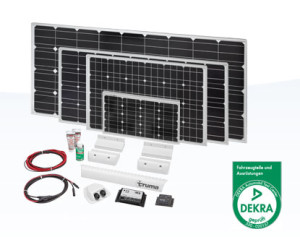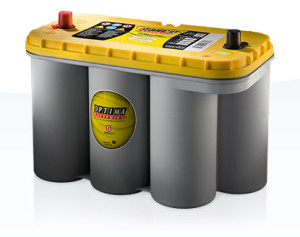A reliable power supply is imperative if you want to make sure manoeuvring your caravan with the Truma Mover® is possible at any time. In conjunction with the Mover® PowerSet, the Truma SolarSet 23 protects the battery of the Truma Mover® against deep discharging. The set also maintains the voltage in the battery, even when it is overcast outside.

Truma Solarset
It is important to keep the battery of the Truma Mover® PowerSet fully charged because the SolarSet23 is only suitable for maintaining the charging level. The Truma BC10 charger is ideal for gentle charging.
Deep discharging and its consequences
The battery has deep discharged, if the battery voltage drops below 10.8 Volt, i.e. more capacity has been drawn from the battery than allowed. The battery capacity should not drop below 70 percent; this ensures a long service life that is measured in charging cycles.
The following factors can lead to deep discharging:
- Discharging through the use of consumers
- Quiet consumers, such as control lamps or LED displays
- Self-discharging
Every time a battery deep discharges, it causes damage, reduces the battery’s charging capacity and service life. Once the battery has deep discharged (lead crystals are formed on the lead plates), it is a matter of luck as to whether it can be saved or not. Deep discharging can be recognised by measuring the voltage of the battery. If the battery voltage lies below the end-point voltage, it has deep discharged.
If this is the case, an attempt can be made to recharge the battery with the Truma BC 10 charger. This involves connecting the battery to the charger for at least 48 hours; however a battery that has deep discharged once rarely ever reaches its full performance again. In many cases, the battery is so severely damaged that it cannot charge at all. In this case, the battery needs to be replaced.
Protection against battery deep discharging via solar charging
After completing the manoeuvring process, it is advisable to disconnect the Mover® from the battery; preferably using a battery isolating switch installed in the vehicle.
Protection against battery deep discharging without solar charging
After completing the manoeuvring process, it is advisable to disconnect the Mover® from the battery; either via the battery isolating switch installed in the vehicle or by disconnecting the positive terminal on the battery. This is realised very simply via the Easy click® pole terminal.
Our tip: Frost can also damage the battery. Therefore, always remove the battery from the vehicle during the winter, and store fully charged in a dry, cool but frost-free place. This process also extends the service life of the battery.
General information about batteries
The issue of deep discharging not only applies to the battery of the Truma Mover®, which is why all tips offered here are of a general nature. Batteries in recreational vehicles will also discharge over time, even if they are disconnected. Therefore, recharge them at the latest every two months.
- The total charging time of the battery should be 24 hours. This also applies even if the battery has only discharged slightly.
- Only use chargers that are suitable for the battery type (wet / gel / AGM / OPTIMA®) and have an adequate level of charging current (A). In the worst case, an unsuitable charger can destroy the battery.
- Some chargers offer the option of selecting between wet and gel batteries, but only the Truma BC10 charger offers the possibility of selecting a specific charging curve for OPTIMA® batteries. This allows optimum charging that will significantly extend the service life of the battery.





